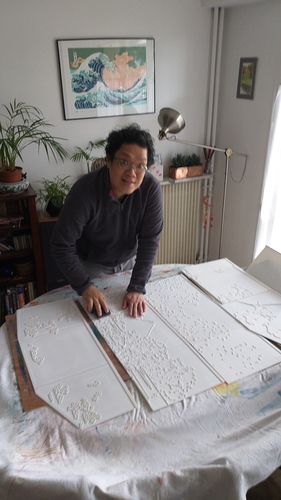
Not for beginners - Mount Fuji Behind Cherry Trees . Part 2/2
pinshape
With this 3D printed woodblock Ukiyo-e technique, you can print as many beautiful pictures as your imagination desires. Printing is a super relaxing and enjoyable way to spend the day, and all you need is someone with a 3D printer and some basic art supplies on hand. These 3D files were carefully created by manually tracing lines and colour separating instead of using automatic software, which produces warmer reproductions of the original artwork, much like listening to a vinyl record rather than digital music. The result, in my opinion, is a more beautiful and true-to-life version of famous Japanese works. You can print your own pictures using acrylic, watercolour or even ink on paper or cloth. This design is a large extra-wide landscape print for a paper size of approximately 800mm wide x 300mm tall, but I recommend slightly larger paper size to allow for a border. It consists of 8 'woodblocks' made from 3 x 3D printed panels each (The panels used to print the mountain are only two). There are 23 plates in total, and each panel must be taped together with gaffer tape to make one 'woodblock' (see example pic), resulting in 8 full-sized plates/8 different colours. You can refer to my finished image or even the original for a colour reference, but feel free to choose your own colours by all means. Sometimes the files are named with the suffix 'top' and 'bottom' to help you figure out which ones to tape together, sometimes A,B and C etc. I have also included instructions about which plates need to be used first and last, often numbering all the files to show the full order in which they should be used, so when you start printing with paint, you don't get a strong layer of colour hiding the layers beneath it. The plates will last for many, many prints, and if you use acrylic which dries in just a few minutes, you won't have to wash the first layer of old paint off. In fact, the surface gets a bit better after one layer of old paint has dried onto it, but you should wash paint off from subsequent print sessions to avoid build-up. I usually place them in soapy water and wash them all together only when I'm done with the session. 3D Print settings: I personally use a 0.6mm nozzle and a 0.3mm layer for speed, but the regular 0.4mm nozzle with a 0.2mm layer will give you even better detail but takes longer. The prints generally require a 300mm x 300mm print size, if your 3D printer is smaller then just scale the plates down. But only scale in the X and Y directions, not the Z, as you must maintain the same thickness for the ukiyo-e printing technique to work properly. Use printer settings that create 100% solids rather than honeycomb inside, as the results will be better. Don't just set 100% infill setting to achieve a solid print, as this will normally make the 3D printer do long stretches of print head zigzagging while it tries to do a very fine honeycomb structure, causing lots of vibrations and noise. Instead, by specifying a high enough number for the 'top/bottom infill layers', higher than the number of actual layers required to print the panel, the printer is forced to do a more efficient back and forth movement pattern (just like it does for normal bottom and top layers) for every single layer, resulting in a better version of 100% infill, with smoother movement and less vibes. After printing each plate, use a sanding block and 120+ grit sandpaper to make the top surface really flat so it holds paint evenly. This doesn't take long if you have used PLA plastic, since it is quite soft. Note: The solid strip of plastic at the top does not need sanding, as it's there for you to attach your paper using masking tape - see my instruction PDF called 'The Kit'. More info can be found at https://bramtan.weebly.com/dev... More designs will come soon!
With this file you will be able to print Not for beginners - Mount Fuji Behind Cherry Trees . Part 2/2 with your 3D printer. Click on the button and save the file on your computer to work, edit or customize your design. You can also find more 3D designs for printers on Not for beginners - Mount Fuji Behind Cherry Trees . Part 2/2.
